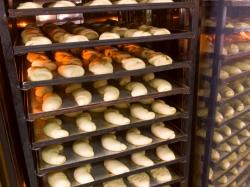How Do Yeast, Salt, And Sugar Impact Bread And Roll Products?
December 23, 2016 | 2 min to read

When producing breads and rolls, many different ingredients impact the finished product. Let’s look at some key players!
Yeast: Yeast's main function in breads and rolls is leavening, which is the process of producing gas (carbon dioxide or CO2). This gas, along with water vapor and entrapped air, then expands during proofing and baking causing the dough to expand (rise). It should be noted that the production of carbon dioxide does not create the air cells in the dough, but rather expands the existing air cells that are trapped during the mixing process. By enzymatic action, yeast converts starch into fermentable sugars, which in turn are converted to carbon dioxide gas and alcohol. The leavening of bread and rolls produces a product that is lighter and more palatable to eat. It has a big impact on the eating quality of the finished product. Leavening is also responsible for the volume of the finished product.
Besides its leavening function, yeast enzyme activity is largely responsible for the conditioning of the dough, which is sometimes referred to as “mellowing” or “maturing” the dough or sponge. Yeast converts sugars (starch) into ethanol alcohol and acids during fermentation. The ethanol alcohol and acids have “mellowing” effect on the dough/sponge giving us biochemical development or maturing of the dough/sponge. Acids lower the pH and have a softening effect on the dough, while the ethanol alcohol also has a maturing effect on the gluten protein. These acids and alcohols makes the gluten more developed resulting in thin, gas-retaining cell walls. This biochemical development develops the dough so it retains its extensibility and elasticity to expand without rupturing during makeup stress and proofing. This helps with dough consistency and results in better characteristics that impact the symmetry and grain of the finished product.
To read the rest of the story, please go to: AIB International
